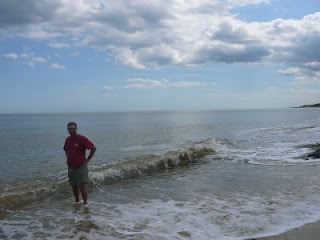

We did the annual trip to Stratford and Warwick on Thursday of last week, then Chris and I took the bikes to Southwold, on the Suffolk coast for Friday and Saturday nights, coming home Sunday evening.
Warwick is an under-rated town, I think. I spent some time in the churchyard of Saint Mary's College Church, which I think is the largest parish church in England, though I may be wrong. I'm especially interested in this church since it is the place where Robert Dudley, the first first Earl of Leicester (yes, that should be two "first"s because I've seen another first Earl of Leicester that wasn't him). One thing that began to strike me, as it struck me also in Dunwich and Southwold, is that these parish churches were centers of their communities in ways that modern churches aren't. Each church has an attached graveyard, with stones dating back two and three hundred years. (In another off-the-wall observation, outside gravestones seem to only remain legible for about 300 years without special cleaning. I've not seen one yet whose inscriptions I can read that dates from before the 18th century. That's not the case with inside markers.) Oh, another difference--people are actually buried in the church: under the floor, in the walls, in the crypt below. Not only is Robert Dudley buried there, but there's also mention of his secret ex-wife Douglass Sheffield, who became Hakluyt's patroness of Wetheringsett. Anyhow, one gets the sense that churches were actually about the end, as well as the beginning, of life. One gets less of a sense of that from modern churches, at least in America.
The Shakespeare production, The Winter's Tale, was well done, but I can't say that I really like the play itself. As well, some of the scenery and costuming (making the pastoral landscape out of fallen books, for example) had a kind of ambiguous symbolic significance. Before the production, we had dinner with Paul and Wendy Hartle, and Diane Facinelli. Ginny Grainger from the RSC also stopped by to see us, in the interval of a conference with some Ohio teachers. The play ended at about 11:15 p.m., then we walked back to the bus. We didn't get into Cambridge until 1 a.m.
This made getting up, packing and getting out to the train station by 8:45 kind of a chore. Because we hadn't bought tickets in advance, we had to wait until 9:45 anyway. It was raining as we left, and rained more fiercely all the way into Suffolk. After a final burst, it stopped at about the time we got off the train to ride to Southwold. We rode to Southwold with a British family group that has a house in the town. I'll primarily give some pictures here to show the town, but it's generally unspoiled and more upscale than Brighton. We were some of the few non-Britons in town, you know, the "odd Americans" that one of the service staff at a pub where we ate said the town gets. ("We get mostly British people here; just the odd American.") So I said that he was right, that we are pretty odd. He was embarrassed. Anyhow, I'll paste some pictures below, which will describe better than anything I can say. We visited Dunwich, which had been an important medieval town before it began crumbling into the sea. I think some early Romantic woman sonneteer wrote about this town and the poignancy of its crumbling, but I can't remember her name. I (though not Chris) went up in the lighthouse in the center of the town, and got a good panorama.






Besides the panorama from the lighthouse, there are two views of Southwold from the pier, one of which shows our B&B, the Avondale (good place to stay). The gravestone is right on the edge of the sand cliff in Dunwich, and that's me with my feet in the North Sea, and Chris at the ruined priory in Dunwich, now being used as a horse pasture and chicken shelter.
Oh, I forgot to mention that we had great weather during our stay in Southwold, and did a loop out to some nature preserves by Dunwich on Saturday. As we got about half-way back to Cambridge, it began to rain. We got home at about 9 p.m. after pedaling in rain to get there.
























